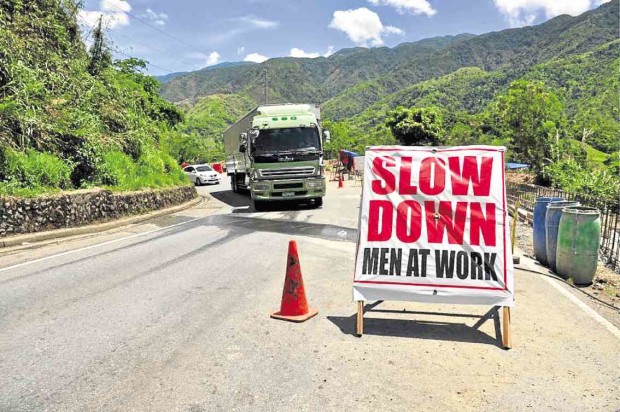After bus crash, DPWH builds wall along ‘killer highway’

A stronger road barrier is being built along this section of the mountain highway linking Nueva Ecija and Nueva Vizcaya provinces to ensure safety of motorists. —MELVIN GASCON
CARRANGLAN, NUEVA ECIJA—Under fire for the April 18 bus accident that killed 33 people and injured 36 others, the Department of Public Works and Highways (DPWH) started putting up a road barrier that could have prevented a series of crashes along the mountain highway here.
The DPWH modified the design for the barrier, a continuous road wall along the section of the road in Barangay Capintalan here where an overloaded Leomarick Trans bus plunged into an 80-meter ravine.
“We are making it a continuous concrete barrier, instead of the original design [for a series of wall segments] that used to have gaps in between. The barrier will be anchored on a slope protection wall to make it stronger,” said Antonio Molano Jr., DPWH director for Central Luzon.
The DPWH is building the P2.5-million, 180-meter long wall as part of measures to ensure road safety along the winding highway leading to the borders of Nueva Vizcaya and Nueva Ecija provinces.
This was after safety engineers observed that a road barrier could have prevented the Leomarick bus from falling off the mountain highway.
Article continues after this advertisementAt the crash site on Thursday, workers were busy pouring concrete on the wall. The highway bend has been turned into a one-lane, stop-and-go section, with aides wielding red and green flaglets to direct the alternating flow of vehicular traffic.
Article continues after this advertisementA white ribbon and a bouquet, with wilted flowers, perched on an ipil-ipil tree by the roadside, marked the spot where the bus fell.
“We are placing bigger reinforcement iron bars, with smaller gaps. If this had been erected earlier, that bus would not have fallen [into the ravine],” said a project engineer, who declined to be named for the story.
Molano said the maintenance of the Cagayan Valley highway section, which included road safety installations, was part of a five-year contract, which was overseen by the DPWH unified project management office (UPMO) under the highways secretary.
He was referring to the five-year, P1.83-billion road rehabilitation project, which was supposed to have begun in 2015 but had been stalled.
The contractor and DPWH officials blamed the delay on insurgency.
However, Maximo Carvajal, UPMO project manager, clarified that the long-term rehabilitation of the Cagayan Valley road did not include the installation of road barriers.
“That is the task of the DPWH district office. Our project only involved the repair of the road pavement,” he said.